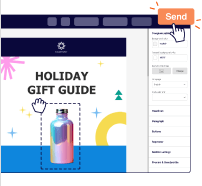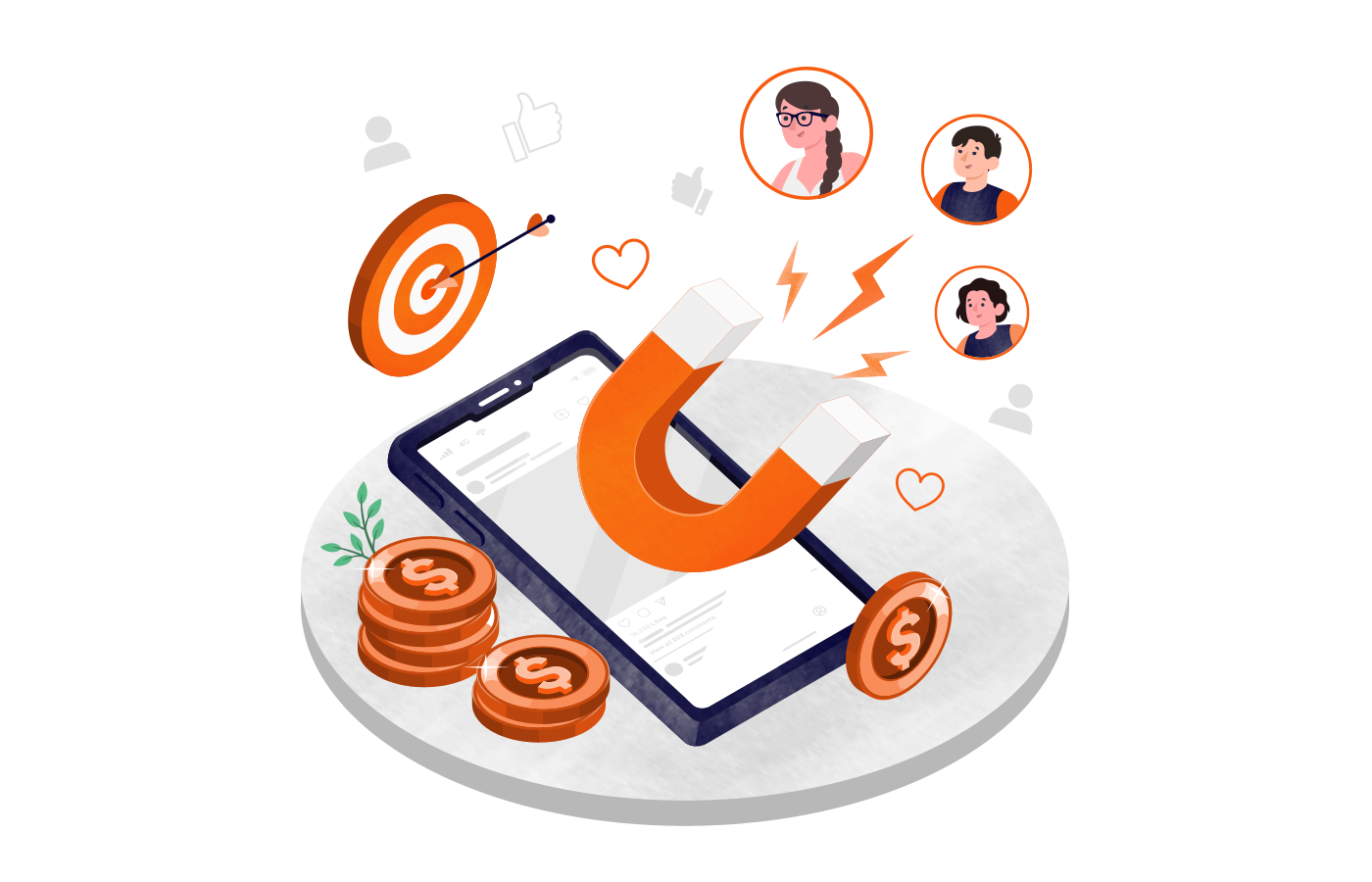Engagement is quickly becoming a key metric in the digital world. Social media platforms are all about tracking how much buzz videos, posts, and images are creating. Meanwhile, big online retailers are figuring out ways to keep visitors browsing their sites longer.
Now, keeping customers engaged is a top priority in marketing plans. Businesses are pulling out all the stops to fully engage every visitor, knowing the payoff can be huge.
But let’s be real: for some, the whole idea of customer engagement is still a bit foggy. There are so many factors at play, which makes nailing down and boosting engagement a tricky task. This article aims to unravel the concept of customer engagement and offer actionable tips to improve this important metric.
What is Customer Engagement?
Customer engagement is the interactions between a customer and your brand. It’s not just the number of interactions (clicks, social media reactions, support contacts), but also their quality.
Genuine engagement involves meaningful, relevant interactions, leading to loyal customer relationships. Artificial tactics to increase engagement (like UI tricks) can lead to customer frustration.
Customer engagement is about how much and how well customers interact with your brand. It’s not just how often they visit your website, like your social media posts, or talk to your support team, but also how meaningful these interactions are.
Some companies try to increase engagement with tricks, like making it hard to log out, but this can upset customers. Good engagement is like a great chat — it should be interesting and feel genuine. When customers really connect with your brand and like what you offer, they’ll interact more and even promote your brand.
The key is real, positive interactions that make customers feel important. This is how you turn people who just browse into loyal fans.
What is a Customer Engagement Model?
- A strategy for businesses to build strong, ongoing relationships with customers;
- Covers the entire customer journey, from first visit to purchase and beyond;
- Uses analytics to evaluate customer interactions with the brand;
- Includes examining customer interactions with non-sales content and customer service;
- Aims to enhance the customer experience and deepen brand connection.
A customer engagement model is a method businesses use to create and maintain good relationships with their customers. The goal is to get customers more involved, which can help the business succeed.
This model looks at the entire experience a customer has with a company, from their first visit to buying something, and even after that. Companies use this model to figure out what’s working well and what’s not in their interactions with customers.
For example, it’s important for a business to see how customers use things like guides or help documents, not just how they buy products. This helps understand what helps customers make purchase decisions.
Customer service is also important. If customers ask a lot of simple questions, it might mean the company needs to give more information at the start.
Overall, a customer engagement model is about understanding and improving how a business interacts with its customers, making their experience better and keeping them connected to the brand.
Why is Customer Engagement Important?
So why is customer engagement key? Because engaged customers are usually loyal customers. They’re the ones who come back for more, spread the word, and give you the feedback you need to grow. They’re not just buying what you’re selling; they’re investing in an experience and a relationship with your brand.
Benefits of using successful customer engagement strategies:
- Customer retention. Engagement boosts customer loyalty. Why is this important? Mostly because it’s a lot cheaper and more effective to keep existing customers than to acquire new ones;
- Enhanced customer satisfaction. Successful engagement leads to happier customers, as their needs and expectations are better met;
- Positive word-of-mouth. Happy customers often become brand advocates, spreading positive reviews and recommendations;
- Valuable feedback and insights. Engaged customers provide useful feedback, helping you refine products and services;
- Higher revenue. Strong customer engagement often translates into increased sales and revenue for the business;
- Competitive advantage. Effective engagement strategies can set your brand apart, giving you an edge in the market;
- Improved crisis management. A well-engaged customer base can be more understanding and supportive during challenging times;
- Customer lifetime value. Regular engagement can enhance the long-term value of customers through repeated business and brand loyalty;
- Innovation drivers. Customer interactions often yield fresh ideas and insights, driving innovation;
- Reduced churn. Engaging customers reduces the likelihood of them leaving for competitors, decreasing churn rates.
Customer Engagement Strategies & Examples
Customer engagement follows the old sales truism that staying on the mind of your lead is the best way to keep them involved. Customer engagement marketing strategies work like that, too.
However, you have to be careful with your customer engagement marketing strategy to avoid spamming people. Let’s look at some things you can do to engage customers.
Focus on Customer Experience (CX)
If we were to pick an obvious step to drive customer engagement, improving CX would be the one. Customers seem to almost overvalue good experiences over products and services. Customer experience is closely related to engagement.
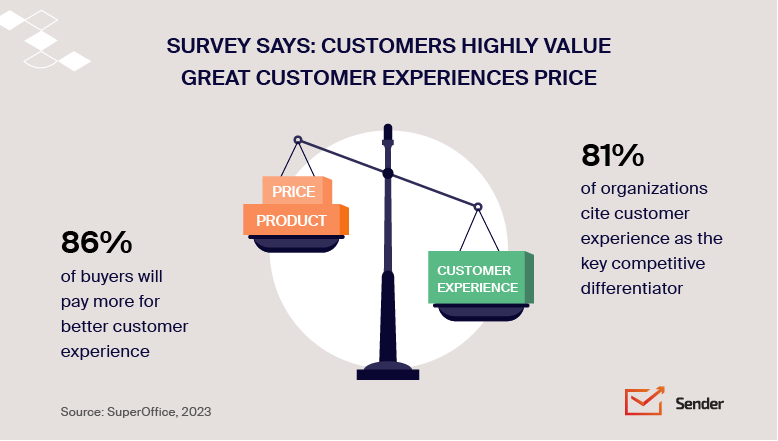
Improving customer experience is challenging, though. It involves many steps and can be achieved in different ways, which is why there are so many roles specializing in user experience, like user experience (UX) designers, customer service managers, and usability researchers.
We won’t be able to summarize what all of them do in this article. But here are four things you should focus on.
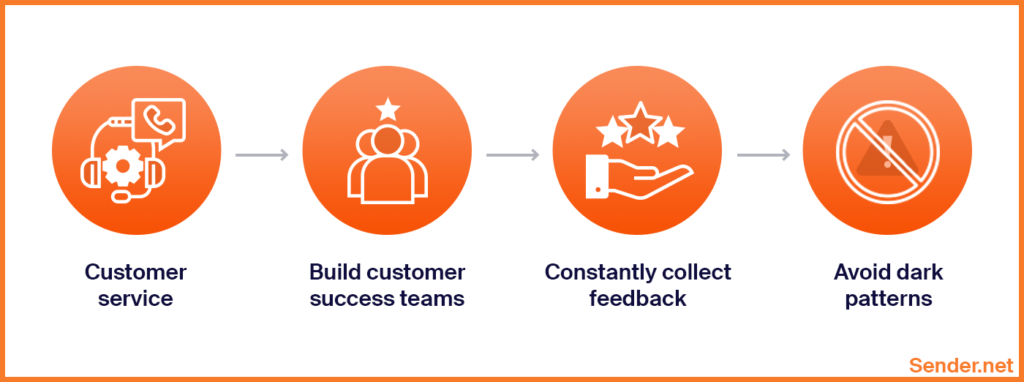
- Customer service. Do a complete review of your customer service practices. Analyze data such as how long it takes to resolve issues, collect service quality indicators (e.g. NPS), etc;
- Build customer success teams. Success teams are essential if your business has long journeys, such as in SaaS. Customers will get lost, need help, or want support even after purchase. Providing such success-based support goes a long way toward building a positive CX;
- Constantly collect feedback. Your customers are the best source of information. After all, you’re trying to make the experience better. So, measure customer engagement regularly. And there’s no way to access how your customers feel other than asking via survey email;
- Avoid dark patterns. Dark patterns are user experience strategies that make doing things that may impact the business negatively (such as logging out or unsubscribing) difficult. While they pump the numbers up, it negatively impacts customer experience and retention in the long run.
It’s important to keep in mind that the heart of excellent customer experience lies in real, human connections. Remember that your audience isn’t just a bunch of nameless customers or business entities.
At the end of the day, you’re always marketing to humans. Increasingly, businesses are catching on to this fact. This is why H2H marketing is gaining so much traction.
Personalized Experience
With a shift in customer expectations, personalization has become a critical element for businesses to focus on. According to McKinsey, 71% of consumers expect companies to deliver personalized interactions and 76% express frustration when this doesn’t happen.
Mass content is no longer as appealing and thus makes it hard to keep clients engaged with your brand. What you need to do is incorporate personalization across various channels, such as email and SMS marketing, if you want a good level of customer interaction.
Simple touches like using a customer’s first name or other personal details can make a big difference. One easy yet impactful strategy is sending birthday greetings via email or SMS. This gesture, while almost cost-free, plays a significant role in fostering strong customer relationships.
It’s also important to personalize the sales process. A great way to do this is by opting for a consultative selling approach, which is all about understanding the customer’s unique needs and tailoring your sales pitch accordingly.
It’s less about pushing a product and more about being a problem-solver for your clients. By doing this, you’re not only addressing their specific concerns but also building trust and a more personal connection.
Customer Rewards
Rewarding customers can be done for various reasons, but focusing on rewarding loyalty and encouraging feedback are particularly effective strategies. In the realms of retail and ecommerce, this often translates into discount codes, offering a tangible thank you for their continued patronage.
For certain sectors, giving away free merchandise as rewards can be more impactful than small discounts. While this approach might have a higher initial cost, branded items serve as ongoing, cost-effective marketing tools. They’re also excellent for re-engaging customers, who are reminded of your brand every time they use the merchandise.
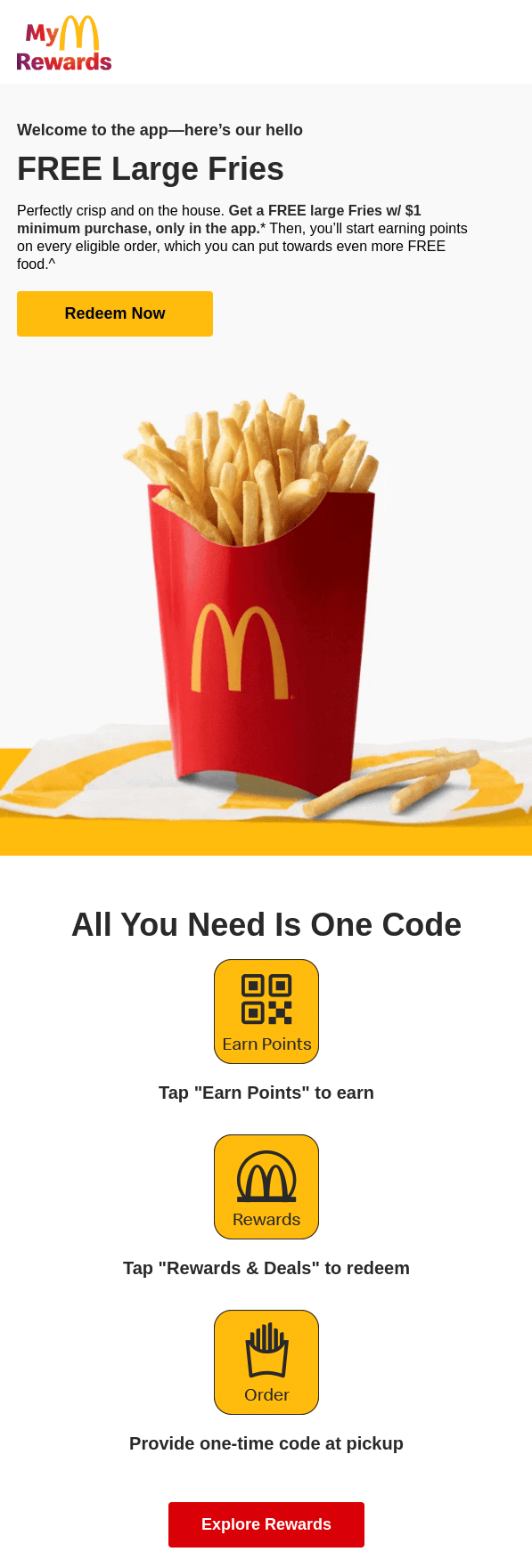
The image above is a tasty example of a customer reward that’s both satisfying and smart marketing. It’s a clever invitation to engage with a brand. McDonald’s is offering free large fries with a minimal purchase, but there’s a catch — you have to use their app.
This not only drives app downloads but also encourages users to make additional purchases. Moreover, by starting a points system, the company ensures that customers keep coming back, building a routine around their visits.
Discover the intricate dynamics of brand loyalty — its definition, various types, and real-world examples — in our featured article: What is Brand Loyalty?
Email Marketing
Email marketing is the foundation of any customer engagement strategy. Setting up emails is easy and cost-effective while providing lots of engagement and re-engagement benefits. What’s more, it almost always gives a great ROI. It’s said that for every dollar spent on email marketing, you’ll get more than 40 dollars in revenue.
Set Up a Newsletter
Having an email newsletter has become the standard for most companies. It’s a fantastic way to keep your customers engaged, even if not everyone reads every single word. The beauty of newsletters? They’re super cost-effective and can really make a difference in how people see your brand.
When it comes to putting together a newsletter, it’s not just about jotting down some thoughts. You’ve got to have a game plan. A good rule of thumb is to send something out monthly, pack it with stuff your readers will find useful (think tips, insights, or even a sweet discount), and keep it short and sweet. Nobody likes to wade through a long email that’s just full of fluff.
Planning ahead for each edition is a smart move. Also, using a solid email platform can make your life a whole lot easier. Sender is a great choice – it’s easy to get the hang of, and provides access to premium features such as email automation and SMS campaigns.
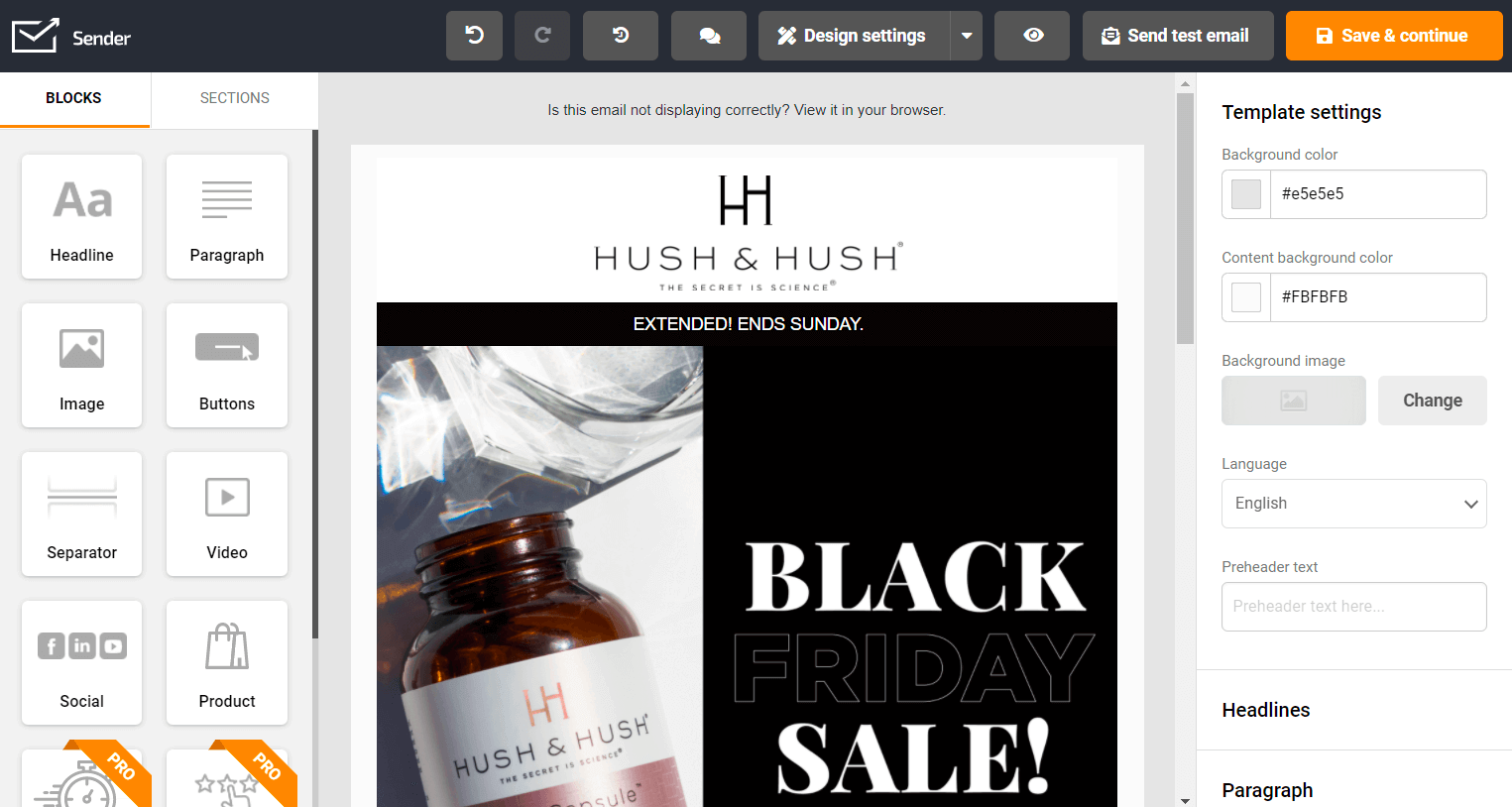
And yes, there’s a free option that lets you send up to 15,000 emails a month without spending a dime! Sender is specifically designed with SMBs in mind, incorporating all the essential email marketing features. The key? These features are super user-friendly, so even if you’re new to email marketing, you’ll find it easy to navigate and use effectively.
Another thing to remember: consistency is key with newsletters. But, if you skip one here and there, it’s not the end of the world. Just make sure what you send is interesting and relevant to your audience. Skip the boring bits that don’t really mean much to them.
And remember, most folks skim through emails on their phones, so make your newsletter something they can zip through with a few quick swipes.
A Warm Welcome
In addition to regular newsletters, consider implementing automated emails or sequences for enhanced engagement. A classic and effective approach is to set up a welcome email for new subscribers.
For instance, a succinct and personalized welcome email from WeWork greets new members, prompts account setup, and app download with clear benefits listed and a visible call-to-action button. Accompanied by a visually inviting image of a cozy, book-filled workspace, it sets the stage for what new subscribers can expect.
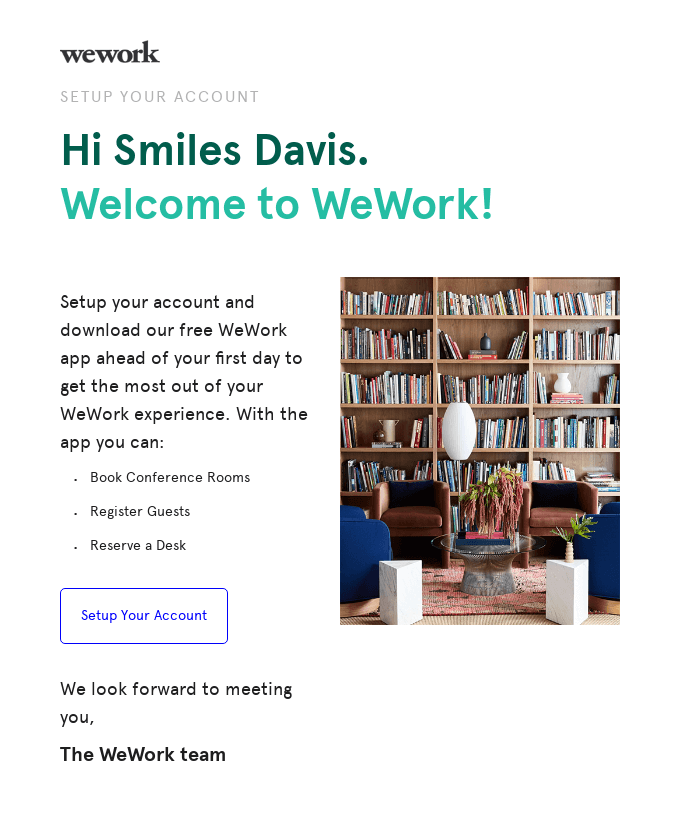
Your welcome email should not only greet new subscribers but also guide them through their next steps. This is especially helpful in ecommerce, where guiding newcomers through your website and brand can significantly improve the online customer experience (CX).
Here are three practical steps:
- Craft a welcome email. Automatically send this to each new customer. These emails typically have an impressive open rate, averaging over 79%, which is double that of regular emails;
- Send an automated welcome SMS. These messages tend to be highly engaging, boasting an average open rate of over 90%;
- Implement welcome push notifications. Use these on your store or app to catch the user’s attention.
Here’s another great example of an introductory email by Zapier. As you can see, it’s concise, with a clear call-to-action, and uses an inviting play button to encourage immediate interaction. Perfect for busy recipients who want to learn quickly and on their own terms.
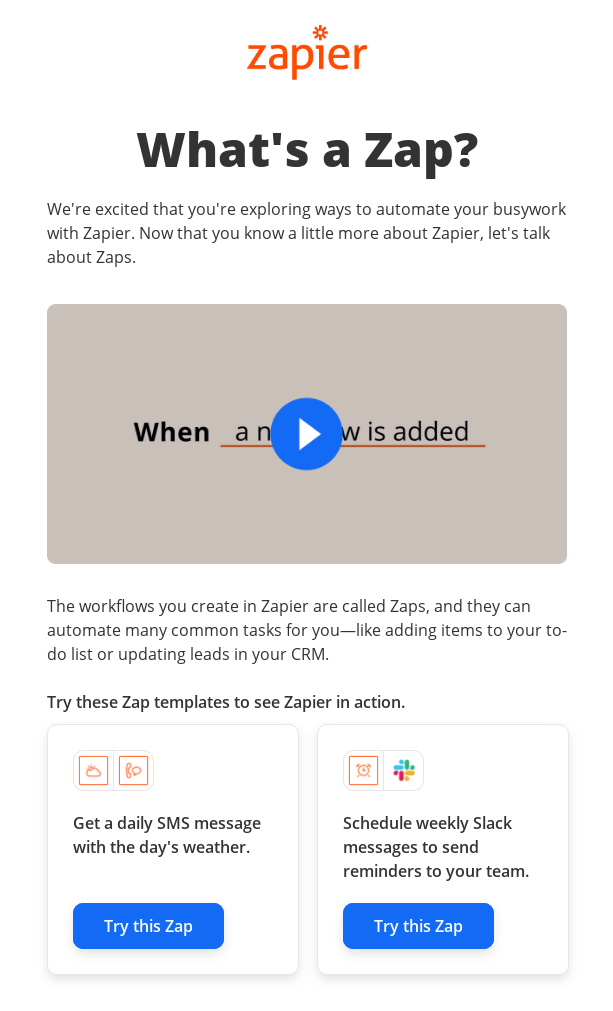
SMS Marketing
SMS marketing is swiftly becoming a go-to strategy for connecting with customers. It’s easy to see why: nearly everyone checks their mobile phone multiple times a day. This means that SMS is a powerful tool for quickly capturing someone’s attention.
Statistics reveal a striking advantage of SMS marketing: a staggering 98% of SMS messages are opened, and 90% of these are read within just three minutes. Think about that. A 98% open rate! In contrast, even the best-performing emails typically only see open rates of 20-25%. SMS marketing is clearly a powerful tool for driving customer engagement.
Remember to keep the SMS messages short, sweet, and action-packed. They work best with a single clear call-to-action with a relevant link. Most companies use SMS marketing to collect feedback, send discounts, SMS notifications, or short updates.
Here’s a good example of an SMS that gets straight to the point, and offers something that might push the receiver to make a purchase. It has a link to easily access the online store and an option to opt-out. Everything a good SMS campaign needs.
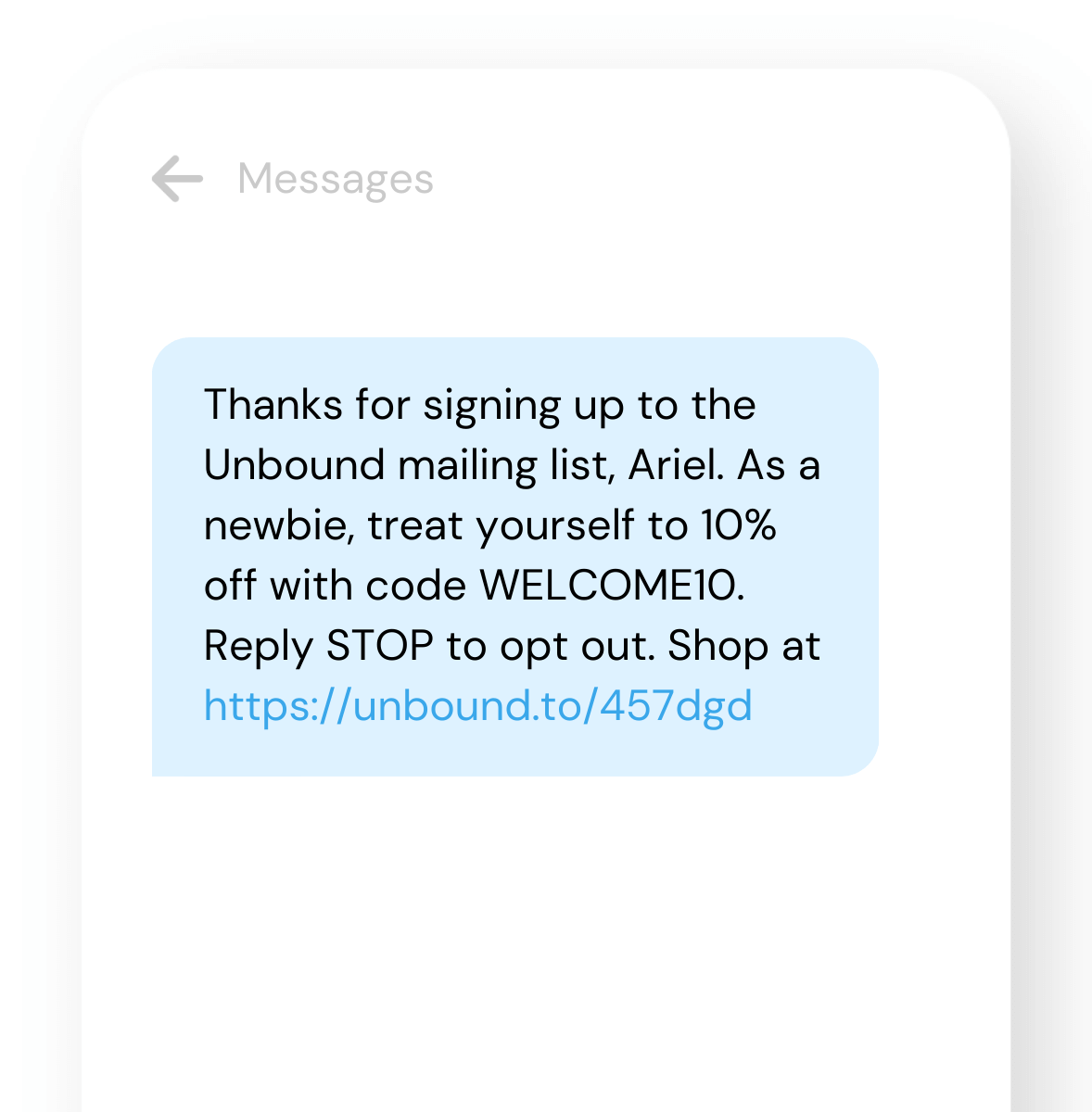
Need more insights on SMS marketing? Check out this article: What are SMS Campaigns? Definition, Examples
Social Media Interactions
Social media platforms provide a space for real-time interaction, which is really important in any customer engagement strategy.
Here are some effective ways to use social media for customer engagement:
- Respond to comments and messages. Don’t leave your followers hanging. Whether it’s a thumbs up on their comment or a quick reply to their message, let them know you’re listening. It’s like giving a high five – it feels good and builds a bond;
- Create engaging content. Post content that resonates with your audience. This can range from informative posts and behind-the-scenes glimpses to interactive polls and quizzes. The key is to create content that sparks conversation and encourages sharing;
- Build a community. Got a product that needs a bit of explaining? Create a community where fans can swap tips and tricks or just share their love for what you do. It’s like having your own fan club, minus the secret handshake;
- Run contests and giveaways: Who doesn’t love free stuff? Contests and giveaways get people excited and talking about your brand. Just keep it simple – nobody likes complicated rules;
- Collaborate with influencers: Get on board with influencers who really get what your brand is about. This approach boosts brand awareness, targets specific audiences effectively, and enhances credibility.
Loyalty Programs
Here’s the deal with loyalty programs: they’re not just about giving points for purchases. It’s about creating a feeling of belonging and appreciation. You can offer exclusive deals, early access to new products, or special events for members. It’s like having a VIP club, and who doesn’t like feeling a bit special?
But remember, the key to a successful loyalty program is simplicity. Make it easy for your customers to understand and use. No one wants to jump through hoops to get a reward. Here’s an example of a straightforward loyalty program by a Canadian online store called Indigo. As you can see, you don’t always have to go for loyalty points to create a good offer to make your customers feel appreciated.
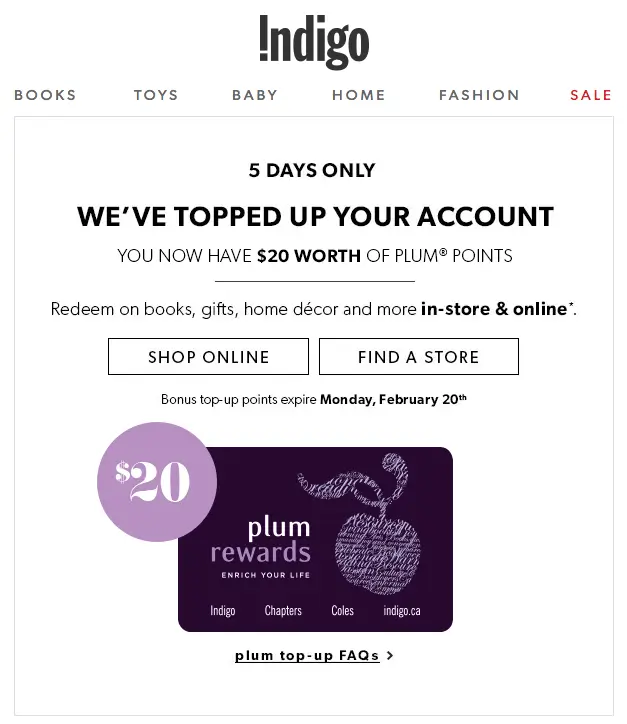
Image source: Enchant Agency
Wondering why loyalty programs are such a big win for customer engagement? They encourage repeat purchases, sure. But they also create an emotional connection. When customers feel valued, they’re more likely to stick around and even spread the word about your brand.
Customer Surveys and Feedback
Don’t underestimate the power of asking for your customer’s opinion. It’s a simple yet effective way to show them that their thoughts and experiences matter to you. By regularly conducting surveys and requesting feedback, you not only gather valuable insights but also reinforce customer engagement.
For example, a promotional email from Dairy Queen invites customers to share their thoughts through a cheerful “Your Opinion Matters” survey, complete with appetizing images of their products, emphasizing the brand’s desire to bring happiness to their patrons and highlighting the direct line of communication with their consumer base.
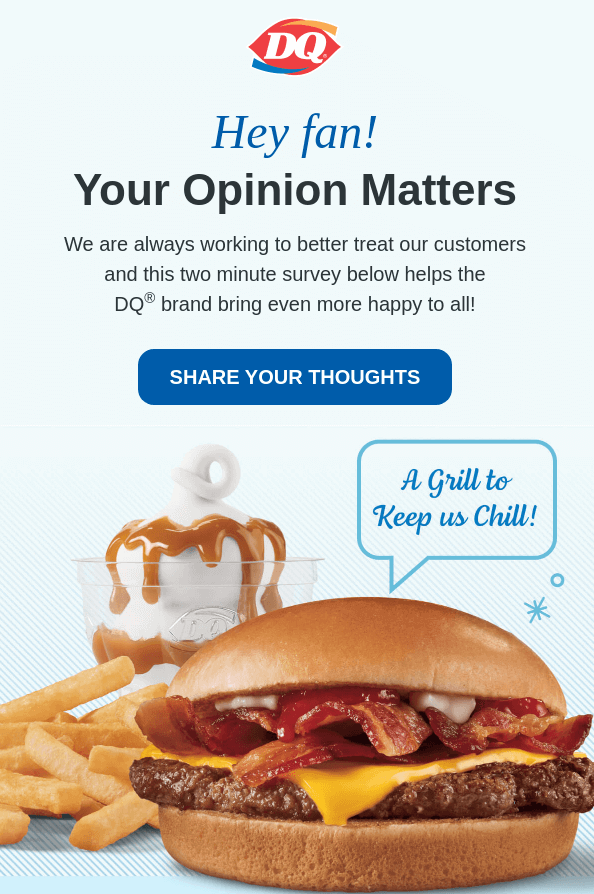
Creating a feedback loop can be as straightforward as sending out a quick survey after a purchase or service experience. But here’s the kicker: act on that feedback. Customers feel more connected to a brand when they see their suggestions being implemented or at least acknowledged. It’s like they’re part of your team, helping to shape the services or products.
Also, don’t forget to share back. When you make changes based on customer feedback, let them know. It shows that you’re not just collecting feedback for the sake of it but actually using it to improve.
User-Generated Content (UGC)
Encouraging your customers to create content about your brand is a goldmine for engagement. It can be anything from reviews and testimonials to photos and videos of them using your product.
This not only provides you with authentic content but also amplifies engagement, as customers love seeing their content being appreciated and shared by a brand. Just like this example from an email sent to Society6 followers.
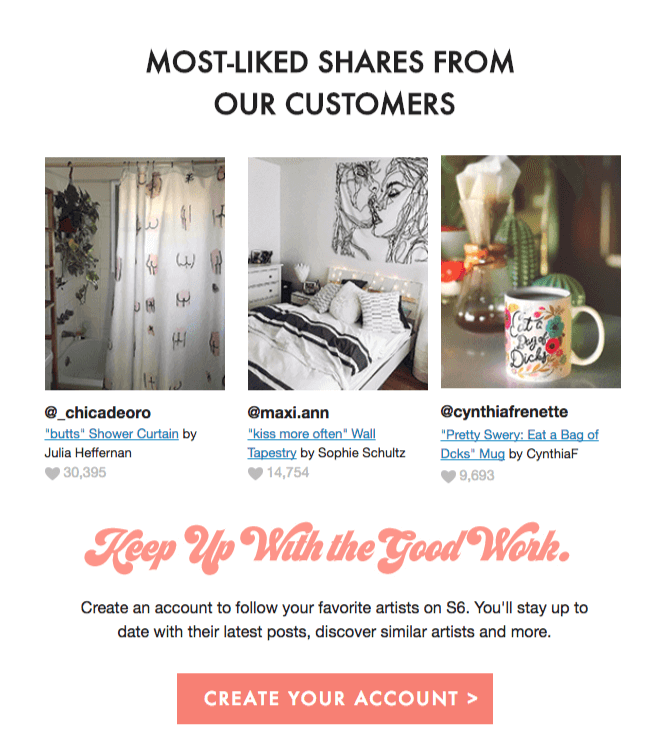
Leverage this content on your social media, website, or even in your advertising. It’s a win-win: you get genuine content, and your customers get a moment in the spotlight.
Customer Support Interactions
Customer loyalty is hard to acquire and easy to lose. Engagement is no different. Similarly, keeping customers engaged requires constant effort. To stay top of mind, you need to offer top-notch service consistently.
Support for customers is key to keeping them happy. It’s like a safety net – they know you’ve got their back if something goes wrong. Fast and helpful support can change a bad situation into a good one, making sure your customers stay with you.
The trick is to keep your support easy to reach and friendly. Think of things like live chat, contact info that’s easy to find, and a team that knows their stuff and is ready to help. You want your customers to feel listened to and important, not just like they’re waiting in line.
Also, use these chances to get feedback, just like with surveys. For example, the Dropbox support feedback email directly asks customers how satisfied they were with the support they received, showing a simple yet effective scale from ‘Very dissatisfied’ to ‘Very satisfied’.
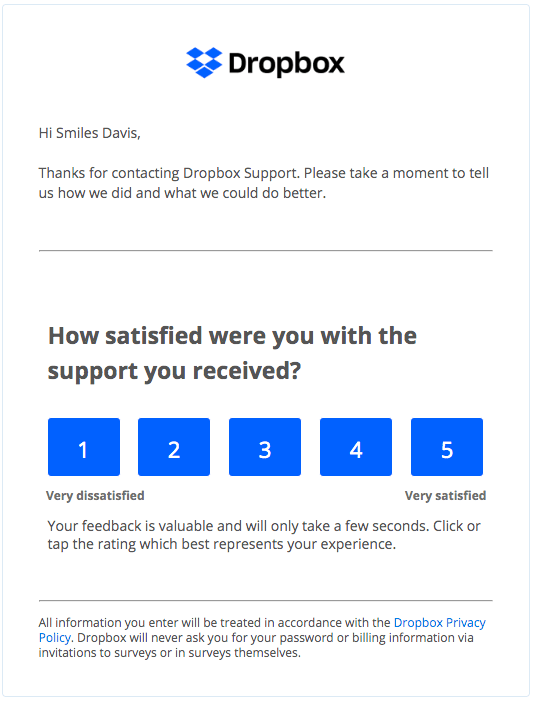
Every chat or email is an opportunity to find out what’s working and what isn’t. That way, your support does more than just solve problems – it helps make the whole customer experience better, driving customer engagement.
Implement a Multichannel Strategy
To gather a crowd of engaged and loyal customers, it’s crucial to meet them on their turf, not just yours. That’s why rolling out multichannel or omnichannel strategies is so important.
Think of it this way: It’s all about being where your customers hang out, whether that’s on social media, through emails, SMS, or any other platform they’re into. This approach isn’t just about being available; it’s about making things super convenient and smooth for your customers. It’s like showing up at the party in all the right places, ready to mingle and make meaningful connections.
With a solid multichannel strategy, your brand doesn’t just wait to be discovered. Instead, you actively pop up in the spots your customers already like, making it easy for them to engage with you, no matter where they are.
Creating a multichannel strategy starts with understanding your audience: where they hang out online, their preferences, and their behaviors. This intel guides you in selecting the right mix of channels — be it social media, email, SMS, or others.
For those who haven’t begun utilizing multichannel marketing, we’d recommend picking two or three channels that are going to be combined. Trying to do everything at once will just end in failure. Two of the simplest picks are either email and SMS or email and social media.
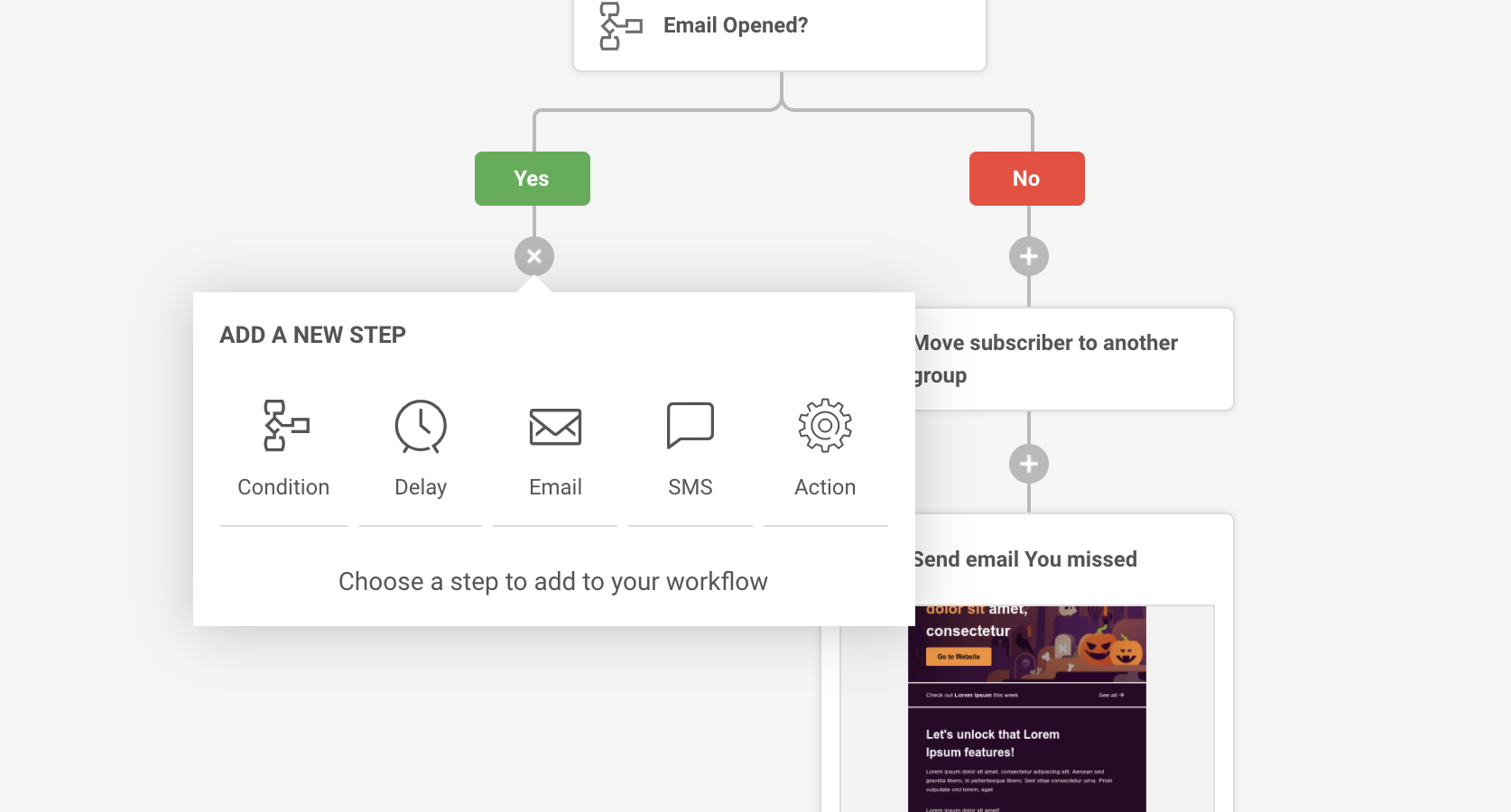
Once your channels are picked, it’s about crafting a consistent yet tailored message for each. This means maintaining a unified brand voice while adapting the content to fit each platform’s unique style. Constantly monitoring and analyzing performance across these channels helps refine your approach, ensuring your strategy stays as dynamic and engaging as the customers you aim to connect with.
Part of the process is integrating data from all channels into one system. While it’s significantly more complicated than building a newsletter, creating a multichannel strategy is the next big step to improve customer engagement.
Also read:
- 7 Best Customer Engagement Platforms (Free & Paid)
- What is Customer Segmentation? Definition, Examples
- 11+ Omnichannel Customer Engagement Strategies & Definition
Key Takeaways
Understanding and focusing on customer engagement not only enhances customer experience but also fosters loyalty and advocacy for your brand. The key thing to remember here is the importance of genuine, personalized engagement in building strong, lasting relationships with your customers.
- Genuine engagement is crucial, surpassing artificial tactics;
- Prioritize customer experience by offering personalized interactions and responsive support;
- Optimize engagement cost-effectively with email and SMS tools;
- Utilize social media for real-time customer interaction and user-generated content sharing;
- Enhance engagement through multichannel strategies across various platforms.
